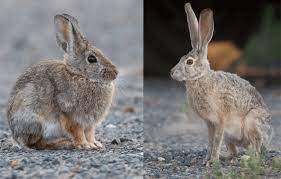Lagomorph Legends: Decoding Hare and Rabbit Behaviors

In the enchanting world of lagomorphs, two prominent species often captivate our imaginations: hares and rabbits. Both hares and rabbits belong to the family Leporidae, and while they share similarities, they each exhibit distinct behaviors that have inspired folklore, legends, and curiosity throughout human history. In this exploration, we delve into the captivating world of lagomorph legends and seek to decode the unique behaviors of hares and rabbits.
Understanding Lagomorphs
Before we dive into their behaviors, let’s clarify what makes hares and rabbits part of the same family. Lagomorphs legends, the order to which hares and rabbits belong, are known for their remarkable reproductive capabilities. They reproduce at an astonishing rate, which has earned them a reputation for fertility and prolificacy in various cultures. Both hares and rabbits are herbivores, primarily feeding on grasses and plants, and are known for their keen senses and agility, making them well-adapted for survival.
Hare: The Fleet-Footed Wonder
Hares are often celebrated for their extraordinary speed and agility. Their unique behaviors have led to various lagomorph legends and stories in different cultures. Here are some of the defining behaviors of hares:
- Speed and Agility: Hares are renowned for their incredible speed, often reaching up to 45 miles per hour. This agility allows them to outrun predators with ease, earning them a reputation for being “fleet of foot.”
- Solitary Creatures: Hares tend to be more solitary in nature, with limited social interactions. They are often seen alone, especially when not mating or raising young.
- Dusk and Dawn Activity: Hares are crepuscular, meaning they are most active during dawn and dusk. This behavior helps them avoid the intense heat of midday and the potential threat of nocturnal predators.
- Leaping and Boxing: During the breeding season, hares engage in a unique behavior known as “boxing.” Female hares may fend off unwanted advances from males by delivering swift kicks with their powerful hind legs.
- Distinct Breeding Patterns: Hares have a different reproductive strategy compared to rabbits. They often give birth to leverets that are more precocial, born with open eyes and fur. This is in contrast to rabbits, which typically give birth to altricial kits.
Rabbit: The Social Burrowers
Rabbits, on the other hand, exhibit behaviors that emphasize their social and burrowing tendencies. These behaviors have led to an array of lagomorph legends and stories in cultures across the world:
- Colonial Living: Unlike hares, rabbits are known for their communal living arrangements. They often reside in burrows with intricate tunnel systems, known as warrens, where they live in groups or colonies.
- Territorial Behavior: Rabbits are territorial creatures, with a defined home range around their warren. They will mark their territory with scent markings and can be quite protective of it.
- Maternal Care: Female rabbits are known for their dedicated maternal care. They give birth to altricial kits, which are born blind and without fur. Mother rabbits provide warmth, protection, and nourishment to their young until they are weaned.
- Social Grooming: Rabbits engage in social grooming within their groups, helping to strengthen social bonds and maintain hygiene.
- Multi-Generational Living: In some cases, multiple generations of rabbits can live together within a colony, with older siblings assisting in caring for the young.
Lagomorph Legends and Folklore
These distinct behaviors of hares and rabbits have inspired numerous legends and folklore across different cultures. Here are a few examples:
- In Native American folklore, the jackrabbit is often seen as a trickster figure, known for its agility and adaptability.
- In European folklore, the Easter Bunny, a symbol of fertility and new life, is often depicted as a rabbit. This legend is rooted in the idea of rabbits’ prolific breeding habits.
- In Japanese folklore, the “moon rabbit” is a well-known figure that is believed to inhabit the moon, using a mortar and pestle. These lagomorph legends are associated with the markings on the moon’s surface.
- In various African cultures, hares are often portrayed as clever and cunning characters in oral traditions, using their wits to outsmart other animals.
In Conclusion
The captivating behaviors of hares and rabbits have given rise to a wealth of legends and folklore that continue to intrigue and inspire people across the world. Hares, with their speed and solitary nature, are often associated with tales of agility and independence, while rabbits, with their social and maternal tendencies, are symbols of community and nurturing. These lagomorph legends reflect the enduring fascination that these lagomorphs hold in our collective imagination. Understanding their behaviors not only enriches our cultural heritage but also deepens our appreciation for these remarkable creatures.



